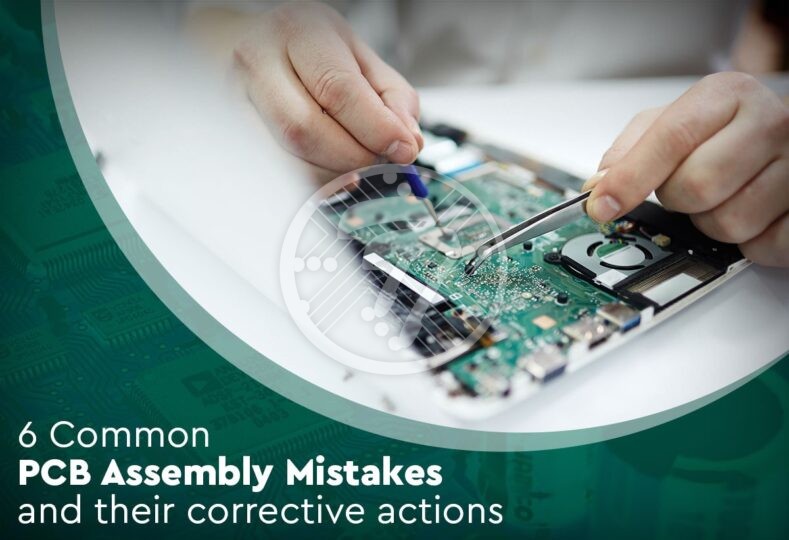6 Common PCB Assembly Mistakes and Their Corrective Actions

When it comes to reliability of the final product, high-quality PCB fabrication and assembly plays a key role. With PCB designs becoming more and more complex, lack of proper planning can lead to high failure rates. Read on to ensure that you understand these common faults, what causes them and most importantly how they can be prevented.
Top 6 common PCB manufacturing defects that a little prudence can be avoided
#1 No Design for Manufacturability Checks
The most common mistake made is that early design for manufacturability checks are not conducted. These significantly reduce the risk of common PCB faults that are known to occur. These checks, when conducted, at the design stage itself ensure that any corrections that may be necessary are made so that costly errors can be avoided in the manufacturability stage. DFM enables manufacturers to look at the design of the product in terms of aspects such as dimensions, materials, functionality and more. DFM also makes it possible to find alternate, optimal manufacturing methods. Therefore, it helps to save both time and money as design flaws if any, are caught well before manufacturing begins. The lack of these checks, on the other hand, leads to costly halts in production and wasted runs.
#2 Solder Bridges
This is one of the most common defects in PCB Assembly. As its name suggests, it takes place when two or more pads become connected creating a bridge. The added issue with solder bridges is that they are very hard to detect on account of their size. Solder bridges are known to happen primarily on account of:
- Insufficient solder layer between pads
- Insufficient gap between pads
- Incorrectly placed components
- Improper seal between the stencil and bare board during the printing process.
An undetected solder bridge can lead to PCB damage on account of burning of components. It is therefore important to take note of the above factors to prevent solder bridges.
#3 Plating Voids
Uneven copper coating on the inside walls of holes on the PCB leads to a situation where the passage of electricity from through holes is impacted. This can be on account of several factors such as:
- Material contamination
- Contaminated holes
- Air bubbles in the material
To ensure that plating voids are avoided, it is important to follow the manufacturer’s directions thoroughly during use. This could be in terms of the correct speed of the drill or recommended number of drill hits. A drill that is too fast can create issues with rough surfaces being created. While a drill that is too slow can lead to drill smear.
#4 De-Wetting/Non-Wetting
Another aspect to avoid is de-wetting as well as non-wetting. De-wetting is a condition that results when molten solder coats a surface and then recedes. This leaves irregularly shaped mounds of solder. Non-wetting, on the other hand, is a condition in which there is partial adherence of molten solder to the surface and the metal remains partially exposed.
To avoid these, it is important to ensure that the components have not expired and that the flux hasn’t been overused.
#5 Electromagnetic Issues
Design flaws can often lead to a situation where the PCB suffers on account of the damaging effect of electromagnetic interference. It is therefore very important to keep this aspect in mind and work on areas such as increasing PCB ground area so that electromagnetic interference is reduced and PCB can work effectively.
#6 Physical Damage
Oftentimes physical damage that results from environmental stresses during manufacturing also leads to PCB failure. For example, dropping of the PCB during prototyping. This could result in damage to components. The factor that adds to the complexity is that sometimes the damage may not be physically visible. The only option in such cases is to replace the PCB so that you do not have to incur costlier errors once the product is ready or worse still if you have gone to market with the product.
While the above list is by no means comprehensive and there can be a whole lot of factors that can result in PCB issues, these are the most common ones that can be easily avoided with some planning. In fact, with PCBs becoming smaller in size and more complex, there are many aspects need a close watch on, to ensure success. It is imperative, therefore, that you partner with experts who can preempt many of these issues, which if not stymied early can have far-reaching consequences.
Technotronix offers PCB Assembly service with 40 years of expertise. Our accurate PCB assembly process meets the quality standards, including ISO 9001:2015, RoHS, and more. Our superior engineering capabilities mean that each board matches your exact requirements and technical specifications. In case if you have any questions, please feel free to contact us via email at [email protected]






